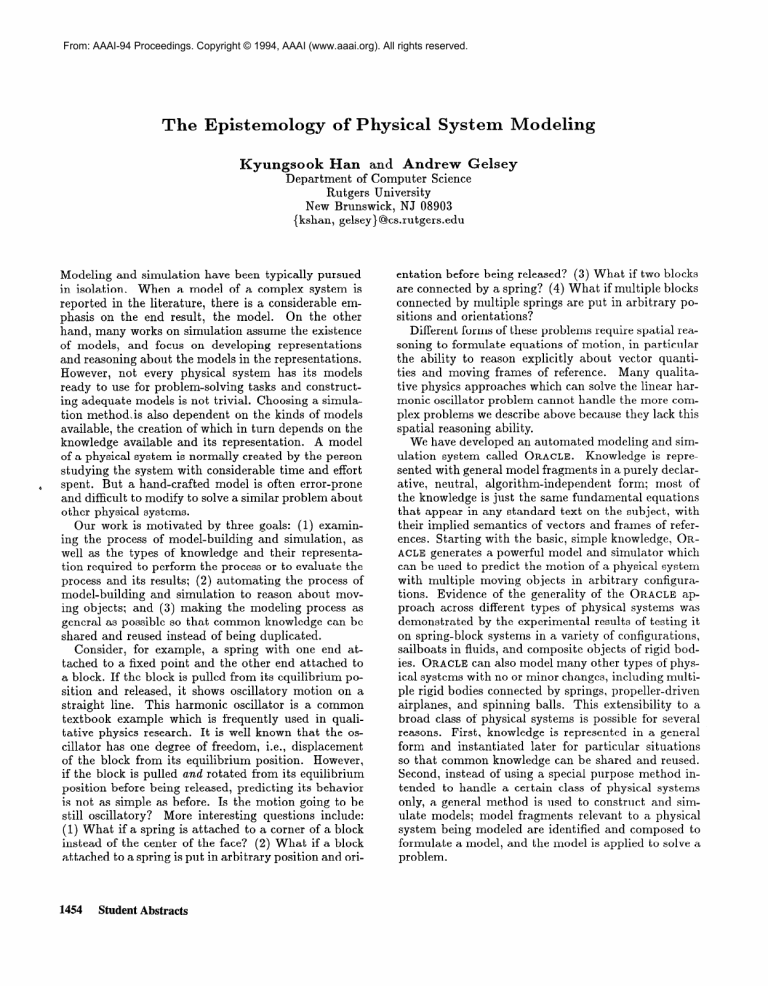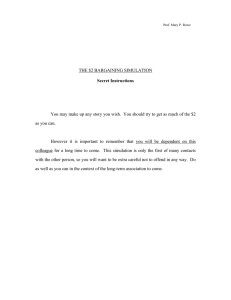
From: AAAI-94 Proceedings. Copyright © 1994, AAAI (www.aaai.org). All rights reserved.
The Epistemology
Kyungsook
of Physical
Han
System
and Andrew
Modeling
Gelsey
Department
of Computer Science
Rutgers University
New Brunswick, NJ 08903
{kshan, gelsey}@cs.rutgers.edu
4
Modeling and simulation have been typically pursued
in isolation.
When a model of a complex system is
reported in the literature,
there is a considerable
emphasis on the end result, the model.
On the other
hand, many works on simulation assume the existence
of models, and focus on developing representations
and reasoning about the models in the representations.
However, not every physical system has its models
ready to use for problem-solving
tasks and constructing adequate models is not trivial. Choosing a simulation method.is
also dependent on the kinds of models
available, the creation of which in turn depends on the
knowledge available and its representation.
A model
of a physical system is normally created by the person
studying the system with considerable
time and effort
spent. But a hand-crafted
model is often error-prone
and difficult to modify to solve a similar problem about
other physical systems.
Our work is motivated by three goals: (1) examining the process of model-building
and simulation,
as
well as the types of knowledge and their representation required to perform the process or to evaluate the
process and its results; (2) automating
the process of
model-building
and simulation
to reason about moving objects;
and (3) making the modeling process as
general as possible so that common knowledge can be
shared and reused instead of being duplicated.
Consider,
for example,
a spring with one end attached to a fixed point and the other end attached to
a block. If the block is pulled from its equilibrium position and released, it shows oscillatory
motion on a
straight line. This harmonic oscillator is a common
textbook
example which is frequently used in qualitative physics research.
It is well known that the oscillator has one degree of freedom, i.e., displacement
of the block from its equilibrium
position.
However,
if the block is pulled and rotated from its equilibrium
position before being released, predicting its behavior
is not as simple as before. Is the motion going to be
still oscillatory ? More interesting
questions include:
a
i
a
s
rin
is
attached
to
a
corner of a block
(1)wht
f
P g
instead of the center of the face? (2) What if a block
attached to a spring is put in arbitrary position and ori-
1454
Student Abstracts
entation before being released? (3) What if two blocks
are connected by a spring? (4) What if multiple blocks
connected by multiple springs are put in arbitrary positions and orientations?
Different forms of these problems require spatial reasoning to formulate equations of motion, in particular
the ability to reason explicitly about vector quantities and moving frames of reference.
Many qualitative physics approaches which can solve the linear harmonic oscillator problem cannot handle the more complex problems we describe above because they lack this
spatial reasoning ability.
We have developed an automated modeling and simulation system called ORACLE. Knowledge is represented with general model fragments in a purely declarative, neutral,
algorithm-independent
form; most of
the knowledge is just the same fundamental
equations
that appear in any standard text on the subject, with
their implied semantics of vectors and frames of references. Starting with the basic, simple knowledge, ORACLE generates a powerful model and simulator which
can be used to predict the motion of a physical system
with multiple moving objects in arbitrary
configurations. Evidence of the generality of the ORACLE approach across different types of physical systems was
demonstrated
by the experimental
results of testing it
on spring-block
systems in a variety of configurations,
sailboats in fluids, and composite objects of rigid bodies. ORACLE can also model many other types of physical systems with no or minor changes, including multiple rigid bodies connected by springs, propeller-driven
airplanes, and spinning balls. This extensibility
to a
broad class of physical systems is possible for several
reasons.
First, knowledge is represented
in a general
form and instantiated
later for particular
situations
so that common knowledge can be shared and reused.
Second, instead of using a special purpose method intended to handle a certain class of physical systems
only, a general method is used to construct and simulate models; model fragments relevant to a physical
system being modeled are identified and composed to
formulate a model, and the model is applied to solve a
problem.






